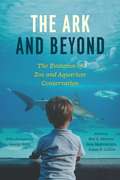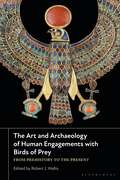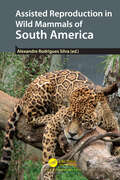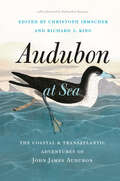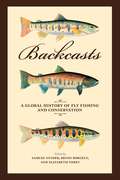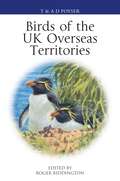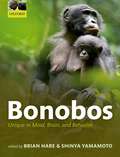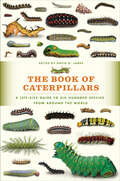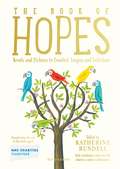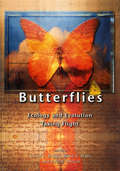- Table View
- List View
The Ark and Beyond: The Evolution of Zoo and Aquarium Conservation (Convening Science: Discovery at the Marine Biological Laboratory)
Scores of wild species and ecosystems around the world face a variety of human-caused threats, from habitat destruction and fragmentation to rapid climate change. But there is hope, and it, too, comes in a most human form: zoos and aquariums. Gathering a diverse, multi-institutional collection of leading zoo and aquarium scientists as well as historians, philosophers, biologists, and social scientists, The Ark and Beyond traces the history and underscores the present role of these organizations as essential conservation actors. It also offers a framework for their future course, reaffirming that if zoos and aquariums make biodiversity conservation a top priority, these institutions can play a vital role in tackling conservation challenges of global magnitude. While early menageries were anything but the centers of conservation that many zoos are today, a concern with wildlife preservation has been an integral component of the modern, professionally run zoo since the nineteenth century. From captive breeding initiatives to rewilding programs, zoos and aquariums have long been at the cutting edge of research and conservation science, sites of impressive new genetic and reproductive techniques. Today, their efforts reach even further beyond recreation, with educational programs, community-based conservation initiatives, and international, collaborative programs designed to combat species extinction and protect habitats at a range of scales. Addressing related topics as diverse as zoo animal welfare, species reintroductions, amphibian extinctions, and whether zoos can truly be “wild,” this book explores the whole range of research and conservation practices that spring from zoos and aquariums while emphasizing the historical, scientific, and ethical traditions that shape these efforts. Also featuring an inspiring foreword by the late George Rabb, president emeritus of the Chicago Zoological Society / Brookfield Zoo, The Ark and Beyond illuminates these institutions’ growing significance to the preservation of global biodiversity in this century.
The Art and Archaeology of Human Engagements with Birds of Prey: From Prehistory to the Present
Of all avian groups, birds of prey in particular have long been a prominent subject of fascination in many human societies. This book demonstrates that the art and materiality of human engagements with raptors has been significant through deep time and across the world, from earliest prehistory to Indigenous thinking in the present day. Drawing on a wide range of global case studies and a plurality of complementary perspectives, it explores the varied and fluid dynamics between humans and birds of prey as evidenced in this diverse art-historical and archaeological record. From their depictions as powerful beings in visual art and their important roles in Indigenous mythologies, to the significance of their body parts as active agents in religious rituals, the intentional deposition of their faunal remains and the display of their preserved bodies in museums, there is no doubt that birds of prey have been figures of great import for the shaping of human society and culture. However, several of the chapters in this volume are particularly concerned with looking beyond the culture–nature dichotomy and human-centred accounts to explore perspectival and other post-humanist thinking on human–raptor ontologies and epistemologies. The contributors recognize that human–raptor relationships are not driven exclusively by human intentionality, and that when these species meet they relate-to and become-with one another. This 'raptor-with-human'-focused approach allows for a productive re-framing of questions about human–raptor interstices, enables fresh thinking about established evidence and offers signposts for present and future intra-actions with birds of prey.
Assisted Reproduction in Wild Mammals of South America
South America has one of the greatest riches in the world in terms of biodiversity. Despite all this richness, recent reports warn of different threats to this biodiversity. As a strategy to reduce the rate of loss of animal species, the development and application of assisted reproduction techniques (ARTs) for their conservation currently stands out. Thus, this book compiles information on recent scientific studies regarding the development of ARTs for the conservation of wild mammalian species in South America, thus serving as an important source of reference for professionals and students interested in wildlife conservation.
Audubon at Sea: The Coastal and Transatlantic Adventures of John James Audubon
This one-of-a-kind, lavishly illustrated anthology celebrates Audubon’s connection to the sea through both his words and art. The American naturalist John James Audubon (1785–1851) is widely remembered for his iconic paintings of American birdlife. But as this anthology makes clear, Audubon was also a brilliant writer—and his keen gaze took in far more than creatures of the sky. Culled from his published and unpublished writings, Audubon at Sea explores Audubon’s diverse observations of the ocean, the coast, and their human and animal inhabitants. With Audubon expert Christoph Irmscher and scholar of the sea Richard J. King as our guides, we set sail from the humid expanses of the American South to the shores of England and the chilly landscapes of the Canadian North. We learn not only about the diversity of sea life Audubon documented—birds, sharks, fish, and whales—but also about life aboard ship, travel in early America, Audubon’s work habits, and the origins of beloved paintings. As we face an unfathomable loss of seabirds today, Audubon’s warnings about the fragility of birdlife in his time are prescient and newly relevant. Charting the course of Audubon’s life and work, from his birth in Haiti to his death in New York City, Irmscher and King’s sweeping introduction and carefully drawn commentary confront the challenges Audubon’s legacy poses for us today, including his participation in American slavery and the thousands of birds he killed for his art. Rounded out by hundreds of historical and ornithological notes and beautiful illustrations, and with a foreword by distinguished photographer and conservationist Subhankar Banerjee, Audubon at Sea is the most comprehensively annotated collection of Audubon’s work ever published.
Backcasts: A Global History of Fly Fishing and Conservation
“Many of us probably would be better fishermen if we did not spend so much time watching and waiting for the world to become perfect.”-Norman Maclean Though Maclean writes of an age-old focus of all anglers—the day’s catch—he may as well be speaking to another, deeper accomplishment of the best fishermen and fisherwomen: the preservation of natural resources. Backcasts celebrates this centuries-old confluence of fly fishing and conservation. However religious, however patiently spiritual the tying and casting of the fly may be, no angler wishes to wade into rivers of industrial runoff or cast into waters devoid of fish or full of invasive species like the Asian carp. So it comes as no surprise that those who fish have long played an active, foundational role in the preservation, management, and restoration of the world’s coldwater fisheries. With sections covering the history of fly fishing; the sport’s global evolution, from the rivers of South Africa to Japan; the journeys of both native and nonnative trout; and the work of conservation organizations such as the Federation of Fly Fishers and Trout Unlimited, Backcasts casts wide. Highlighting the historical significance of outdoor recreation and sports to conservation in a collection important for fly anglers and scholars of fisheries ecology, conservation history, and environmental ethics, Backcasts explores both the problems anglers and their organizations face and how they might serve as models of conservation—in the individual trout streams, watersheds, and landscapes through which these waters flow.
Biology and Conservation of Musteloids
The musteloids are the most diverse super-family among carnivores, ranging from little known, exotic, and highly-endangered species to the popular and familiar, and include a large number of introduced invasives. They feature terrestrial, fossorial, arboreal, and aquatic members, ranging from tenacious predators to frugivorous omnivores, span weights from a 100g weasel to 30kg giant otters, and express a range of social behaviours from the highly gregarious to the fiercely solitary. Musteloids are the subjects of extensive cutting-edge research from phylogenetics to the evolution of sociality and through to the practical implications of disease epidemiology, introduced species management, and climate change. Their diversity and extensive biogeography inform a wide spectrum of ecological theory and conservation practice. The editors of this book have used their combined 90 years of experience working on the behaviour and ecology of wild musteloids to draw together a unique network of the world's most successful and knowledgeable experts. The book begins with nine review chapters covering hot topics in musteloid biology including evolution, disease, social communication, and management. These are followed by twenty extensive case studies providing a range of comprehensive geographic and taxonomic coverage. The final chapter synthesises what has been discussed in the book, and reflects on the different and diverse conservation needs of musteloids and the wealth of conservation lessons they offer. Biology and Conservation of Musteloids provides a conceptual framework for future research and applied conservation management that is suitable for graduate level students as well as professional researchers in musteloid and carnivore ecology and conservation biology. It will also be of relevance and use to conservationists and wildlife managers.
The Birds of Nottinghamshire
The last comprehensive review of Nottinghamshire’s birds was produced more than four decades ago. Much has changed since then, and a new avifauna is long overdue. This book draws together historic reports from the nineteenth century, records from the files of the county bird club (Nottinghamshire Birdwatchers), and data from national and regional surveys and monitoring programmes. The resulting account presents an overview of the present state of the county’s birdlife, set against a context of environmental and climatic change. The gravel pits in the Trent and Idle Valleys form major corridors for birds moving across Britain and Nottinghamshire has attracted more than its share of national rarities. These include Britain’s first Egyptian Nightjar and Lesser Yellowlegs in the nineteenth century, Bufflehead, Redhead, Cedar Waxwing and breeding Black-winged Stilts in the twentieth century, and a memorable nesting attempt by European Bee-eaters in 2017. The woods and heaths of Sherwood lying in the middle of the county also provide a haven for an array of iconic species including European Nightjar, Eurasian Woodcock, Honeybuzzard and Hawfinch. This book describes the past and present status of the 334 species that have been recorded in Nottinghamshire up to 2018. Lavishly illustrated with photographs taken within the county, and sketches from the internationally recognised artist Michael Warren, it is intended to be an authoritative reference to the birds of Nottinghamshire.
Birds of the UK Overseas Territories
The UK Overseas Territories (UKOTs) are scattered across the globe. Most are small islands or island complexes, occurring from the Caribbean to the furthest reaches of the South Atlantic, via the Indian and Pacific Oceans. In terms of global biodiversity, these territories are remarkably significant. Among landscapes that range from coral atolls, through mangroves and dry forests to the ice sheets of Antarctica, the UKOTs support no fewer than 45 species of birds currently considered to be globally threatened. They are also home to a third of all the world's breeding albatrosses, and nine of the world's 17 species of penguin. In a rapidly changing world, the UKOTs symbolise global crises in climate and biodiversity. Threats faced by their wildlife range from mortality of seabirds at sea through industrial fisheries, and on land as a result of introduced ground predators, to the utter devastation of hurricanes in the Caribbean, which provide a stark reminder of our changing climate. The human impact on the wildlife of our planet has been increasing for centuries, but the next few decades promise to be critical. This book explores the birds and other wildlife of each of the 14 UKOTs, with a particular focus on environmental threats and conservation priorities. Written by authors with a deep connection to the sites, this book represents an important stocktake of the biological richness of these special places in the early 21st century.
Blue tit (UEB Uncontracted)
This is an image of a European Blue Tit viewed from the side and facing left so that only one eye and one wing can be found. There is a locator dot shown, which will be at the top left of the page when the image is the right way up. The blue tit has distinctive and colourful plumage. It has a light blue 'crown' on top of its head, a white face with dark blue around it and a dark blue line going through its eyes. It has a yellow chest, green, blue and white wings and a blue tail. The bird is in the centre of the page. Its head is at the top centre with its small grey beak to the left and its eye to the right of this. Down the page is its chest on the left and wing on the right. At the bottom of the image are the bird's two grey legs, each with three toes pointing to the left and one to the right. Its small tail is on the right.
Bonobos: Unique in Mind, Brain, and Behavior
The bonobo, along with the chimpanzee, is one of our two closest living relatives. Their relatively narrow geographic range (south of the Congo River in the Democratic Republic of Congo) combined with the history of political instability in the region, has made their scientific study extremely difficult. In contrast, there are dozens of wild and captive sites where research has been conducted for decades with chimpanzees. Because data sets on bonobos have been so hard to obtain and so few large-scale studies have been published, the majority of researchers have treated chimpanzee data as being representative of both species. However, this misconception is now rapidly changing. With relative stability in the DRC for over a decade and a growing community of bonobos living in zoos and sanctuaries internationally, there has been an explosion of scientific interest in the bonobo with dozens of high impact publications focusing on this fascinating species. This research has revealed exactly how unique bonobos are in their brains and behavior, and reminds us why it is so important that we redouble our efforts to protect the few remaining wild populations of this iconic and highly endangered great ape species.
The Book of Caterpillars: A Life-Size Guide to Six Hundred Species from around the World
The weird and wonderful world of insects boasts some of the strangest creatures found in nature, and caterpillars are perhaps the most bizarre of all. While most of us picture caterpillars as cute fuzzballs munching on leaves, there is much more to them than we imagine. A caterpillar’s survival hinges on finding enough food and defending itself from the array of natural enemies lined up to pounce and consume. And the astounding adaptations and strategies they have developed to maximize their chances of becoming a butterfly or moth are only just beginning to be understood, from the Spicebush Swallowtail caterpillar that resembles a small snake to the Eastern Carpenter Bee Hawkmoth caterpillar that attempts to dissuade potential predators by looking like a diseased leaf. The Book of Caterpillars unveils the mysteries of six hundred species from around the world, introducing readers to the complexity and beauty of these underappreciated insects. With the advent of high-quality digital macrophotography, the world of caterpillars is finally opening up. The book presents a wealth of stunning imagery that showcases the astonishing diversity of caterpillar design, structure, coloration, and patterning. Each entry also features a two-tone engraving of the adult specimen, emphasizing the wing patterns and shades, as well as a population distribution map and table of essential information that includes their habitat, typical host plants, and conservation status. Throughout the book are fascinating facts that will enthrall expert entomologists and curious collectors alike. A visually rich and scientifically accurate guide to six hundred of the world’s most peculiar caterpillars, this volume presents readers with a rare, detailed look at these intriguing forms of insect life.
The Book of Hopes: Words and Pictures to Comfort, Inspire and Entertain
In difficult times, what children really need is hope. And in that spirit, bestselling author Katherine Rundell emailed some of the children's writers and artists whose work she loved most:'I asked them to write something very short, fiction or non-fiction, or draw something that would make the children reading it feel like possibility-ists: something that would make them laugh or wonder or snort or smile. The response was magnificent, which shouldn't have surprised me, because children's writers and illustrators are professional hunters of hope… I hope that the imagination can be a place of shelter for children and that The Book of Hopes might be useful in that, even if only a little.'This collection, packed with short stories, poems and pictures from the very best children's authors and illustrators, aims to provide just that. Within its pages you'll find animal friends from insects to elephants, high-flying grandmas, a homesick sprite, the tooth fairy, and even extra-terrestrial life.There are 133 contributions from authors and illustrators, including Anthony Horowitz, Axel Scheffler, Catherine Johnson, Jacqueline Wilson, Katherine Rundell, Lauren Child, Michael Morpurgo and Onjali Q. Raúf. A donation from the sale of each book will go to NHS Charities Together, in gratitude for the incredible efforts of all those who worked in hospitals over the quarantine period.'An anthology on the theme of hope… it includes a rich range of images, poetry, stories and non-fiction' Stories to charm on endless days, The Sunday TimesThe following proceeds from this ebook will be donated to NHS Charities Together: 35% of publisher's net receipts or at least £1.00 per copy.NHS Charities Together is a charity registered in England and Wales (registered charity no. 1186569)
Budgie (Large Print)
This is an image of a budgerigar facing left and seen from the side with its head pointing to the front so both eyes and beak can be found. There is a locator dot shown, which will be at the top left of the page when the image is the right way up. The bird's yellow head is in the top left of the page. It has two small black eyes with a small beak between them. Down and right are the budgie's green chest and a yellow, black-tipped wing. Down the page are the bird's two legs and feet, and to the right is its long green tail.
Budgie (UEB Contracted)
This is an image of a budgerigar facing left and seen from the side with its head pointing to the front so both eyes and beak can be found. There is a locator dot shown, which will be at the top left of the page when the image is the right way up. The bird's yellow head is in the top left of the page. It has two small black eyes with a small beak between them. Down and right are the budgie's green chest and a yellow, black-tipped wing. Down the page are the bird's two legs and feet, and to the right is its long green tail.
Budgie (UEB Uncontracted)
This is an image of a budgerigar facing left and seen from the side with its head pointing to the front so both eyes and beak can be found. There is a locator dot shown, which will be at the top left of the page when the image is the right way up. The bird's yellow head is in the top left of the page. It has two small black eyes with a small beak between them. Down and right are the budgie's green chest and a yellow, black-tipped wing. Down the page are the bird's two legs and feet, and to the right is its long green tail.
Bumblebee (Large Print)
This is a picture of a bumblebee viewed from the top and facing towards the top of the page. There is a locator dot shown, which will be at the top left of the page when the image is the right way up. Just down the page, there is a silhouette of the bumblebee at approximately real size. At the top, in the centre of the page, is its head with two antennae (feelers) and two eyes. On either side of the head are the front legs, which are connected to the thorax. The thorax is shown down the page with two wings and two legs on either side, and then further down the page is the abdomen which, like the thorax, is striped orange and black, and covered in fine hairs.
Bumblebee (UEB Contracted)
This is a picture of a bumblebee viewed from the top and facing towards the top of the page. There is a locator dot shown, which will be at the top left of the page when the image is the right way up. Just down the page, there is a silhouette of the bumblebee at approximately real size. At the top, in the centre of the page, is its head with two antennae (feelers) and two eyes. On either side of the head are the front legs, which are connected to the thorax. The thorax is shown down the page with two wings and two legs on either side, and then further down the page is the abdomen which, like the thorax, is striped orange and black, and covered in fine hairs.
Bumblebee (UEB uncontracted)
This is a picture of a bumblebee viewed from the top and facing towards the top of the page. There is a locator dot shown, which will be at the top left of the page when the image is the right way up. Just down the page, there is a silhouette of the bumblebee at approximately real size. At the top, in the centre of the page, is its head with two antennae (feelers) and two eyes. On either side of the head are the front legs, which are connected to the thorax. The thorax is shown down the page with two wings and two legs on either side, and then further down the page is the abdomen which, like the thorax, is striped orange and black, and covered in fine hairs.
Butterflies: Ecology and Evolution Taking Flight
In Butterflies: Ecology and Evolution Taking Flight, the world's leading experts synthesize current knowledge of butterflies to show how the study of these fascinating creatures as model systems can lead to deeper understanding of ecological and evolutionary patterns and processes in general. The twenty-six chapters are organized into broad functional areas, covering the uses of butterflies in the study of behavior, ecology, genetics and evolution, systematics, and conservation biology. Especially in the context of the current biodiversity crisis, this book shows how results found with butterflies can help us understand large, rapid changes in the world we share with them—for example, geographic distributions of some butterflies have begun to shift in response to global warming, giving early evidence of climate change that scientists, politicians, and citizens alike should heed. The first international synthesis of butterfly biology in two decades, Butterflies: Ecology and Evolution Taking Flight offers students, scientists, and amateur naturalists a concise overview of the latest developments in the field. Furthermore, it articulates an exciting new perspective of the whole group of approximately 15,000 species of butterflies as a comprehensive model system for all the sciences concerned with biodiversity and its preservation. Contributors: Carol L. Boggs, Paul M. Brakefield, Adriana D. Briscoe, Dana L. Campbell, Elizabeth E. Crone, Mark Deering, Henri Descimon, Erika I. Deinert, Paul R. Ehrlich, John P. Fay, Richard ffrench-Constant, Sherri Fownes, Lawrence E. Gilbert, André Gilles, Ilkka Hanski, Jane K. Hill, Brian Huntley, Niklas Janz, Greg Kareofelas, Nusha Keyghobadi, P. Bernhard Koch, Claire Kremen, David C. Lees, Jean-François Martin, Antónia Monteiro, Paulo César Motta, Camille Parmesan, William D. Patterson, Naomi E. Pierce, Robert A. Raguso, Charles Lee Remington, Jens Roland, Ronald L. Rutowski, Cheryl B. Schultz, J. Mark Scriber, Arthur M. Shapiro, Michael C. Singer, Felix Sperling, Curtis Strobeck, Aram Stump, Chris D. Thomas, Richard VanBuskirk, Hans Van Dyck, Richard I. Vane-Wright, Ward B. Watt, Christer Wiklund, and Mark A. Willis
Butterfly lifecycle 1 (eggs and hatching) (Large Print)
This image shows a scale, an egg, a hatched egg and a newly emerged caterpillar. There is a locator dot shown, which will be at the top left of the page when the image is the right way up. The scale is on the left of the page. To its right is the dark green egg with pale vertical grooves. To the right of this is another egg which is broken open at the top. On the right of the page is the small pale green caterpillar with its head on the right and its anal clasper to the left. Its head has one of its two large eyes showing and one of its two antennae above it. It has a hairy back. Three of its six thoracic legs are to the right and four of its eight stumpy prolegs are to the left.
Butterfly lifecycle 1 (eggs and hatching) (UEB Contracted)
This image shows a scale, an egg, a hatched egg and a newly emerged caterpillar. There is a locator dot shown, which will be at the top left of the page when the image is the right way up. The scale is on the left of the page. To its right is the dark green egg with pale vertical grooves. To the right of this is another egg which is broken open at the top. On the right of the page is the small pale green caterpillar with its head on the right and its anal clasper to the left. Its head has one of its two large eyes showing and one of its two antennae above it. It has a hairy back. Three of its six thoracic legs are to the right and four of its eight stumpy prolegs are to the left.
Butterfly lifecycle 1 (eggs and hatching) (UEB Uncontracted)
This image shows a scale, an egg, a hatched egg and a newly emerged caterpillar. There is a locator dot shown, which will be at the top left of the page when the image is the right way up. The scale is on the left of the page. To its right is the dark green egg with pale vertical grooves. To the right of this is another egg which is broken open at the top. On the right of the page is the small pale green caterpillar with its head on the right and its anal clasper to the left. Its head has one of its two large eyes showing and one of its two antennae above it. It has a hairy back. Three of its six thoracic legs are to the right and four of its eight stumpy prolegs are to the left.
Butterfly lifecycle 2 (caterpillar) (Large Print)
The mature dark grey green caterpillar is shown from the side with its head to the right and a scale at the bottom of the page. There is a locator dot shown, which will be at the top left of the page when the image is the right way up. Its head has one of its two large eyes showing and one of its two antennae above it. Below the eye is one of its mouth parts. It is a hairy caterpillar with spiky hairs on its back and sides. Three of its six thoracic legs are to the right and four of its eight prolegs are to the left. Just above the legs running the length of the caterpillar is a wavy yellow line. The caterpillar ends on the left with its anal clasper.
Butterfly lifecycle 2 (caterpillar) (UEB Contracted)
The mature dark grey green caterpillar is shown from the side with its head to the right and a scale at the bottom of the page. There is a locator dot shown, which will be at the top left of the page when the image is the right way up. Its head has one of its two large eyes showing and one of its two antennae above it. Below the eye is one of its mouth parts. It is a hairy caterpillar with spiky hairs on its back and sides. Three of its six thoracic legs are to the right and four of its eight prolegs are to the left. Just above the legs running the length of the caterpillar is a wavy yellow line. The caterpillar ends on the left with its anal clasper.
Butterfly lifecycle 2 (caterpillar) (UEB Uncontracted)
The mature dark grey green caterpillar is shown from the side with its head to the right and a scale at the bottom of the page. There is a locator dot shown, which will be at the top left of the page when the image is the right way up. Its head has one of its two large eyes showing and one of its two antennae above it. Below the eye is one of its mouth parts. It is a hairy caterpillar with spiky hairs on its back and sides. Three of its six thoracic legs are to the right and four of its eight prolegs are to the left. Just above the legs running the length of the caterpillar is a wavy yellow line. The caterpillar ends on the left with its anal clasper.
